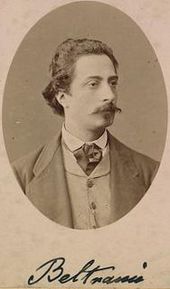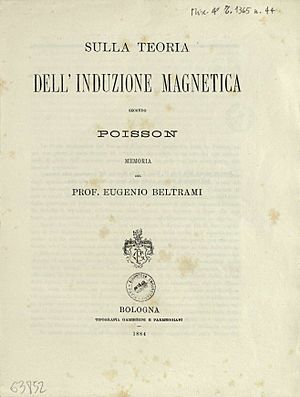Eugenio Beltrami facts for kids
Quick facts for kids
Eugenio Beltrami
|
|
|---|---|

Eugenio Beltrami
|
|
| Born | 16 November 1835 |
| Died | 18 February 1900 (aged 64) |
| Nationality | Italian |
| Alma mater | Ghislieri College, Pavia (no degree) |
| Known for | Beltrami equation Beltrami identity Beltrami's theorem Laplace–Beltrami operator Beltrami vector field Beltrami–Klein model |
| Scientific career | |
| Fields | Mathematician |
| Institutions | University of Bologna University of Pisa University of Rome University of Pavia |
| Academic advisors | Francesco Brioschi |
| Doctoral students | Giovanni Frattini |
Eugenio Beltrami (born November 16, 1835 – died February 18, 1900) was a famous Italian mathematician. He is known for his important work in differential geometry and mathematical physics. Differential geometry is about studying shapes and spaces using math. Mathematical physics uses math to understand how the world works.
Beltrami was especially good at explaining his ideas clearly. He was the first to show that non-Euclidean geometry made sense. This is a type of geometry where Euclid's rules, like parallel lines never meeting, don't always apply. He did this by using special shapes like the pseudosphere and a model called the Beltrami–Klein model. He also helped create a math tool called singular value decomposition for matrices. Matrices are like grids of numbers used in math. His work also helped other mathematicians develop tensor calculus, which is another advanced math tool.
Contents
Life of Eugenio Beltrami
Eugenio Beltrami was born in 1835 in Cremona, which is in Lombardy, Italy. At that time, this area was part of the Austrian Empire. His parents, Giovanni Beltrami and Elisa Barozzi, were both artists.
Early Studies and Challenges
Beltrami started studying mathematics at the University of Pavia in 1853. However, he was asked to leave Ghislieri College in 1856. This happened because of his political views. He supported the Risorgimento, which was the movement to unite Italy.
Because of money problems, he had to stop his studies for a while. For several years, he worked as a secretary for a railroad company. During this time, he was taught and inspired by a mathematician named Francesco Brioschi.
Becoming a Professor
In 1862, Beltrami became a professor at the University of Bologna. This was the same year he published his first research paper. Throughout his life, he held many professor jobs. He taught at the universities of Pisa, Rome, and Pavia.
From 1891 until he passed away, Beltrami lived in Rome. He became the president of a famous science group called the Accademia dei Lincei in 1898. In 1899, he was made a senator of the Kingdom of Italy.
Contributions to Non-Euclidean Geometry
In 1868, Beltrami published two important papers about non-Euclidean geometry. This type of geometry was explored by mathematicians like János Bolyai and Nikolai Lobachevsky.
Understanding Non-Euclidean Shapes
In his paper "Essay on an interpretation of non-Euclidean geometry," Beltrami suggested that this new geometry could be shown on a surface called a pseudosphere. A pseudosphere has a special kind of curve called constant negative curvature.
For Beltrami's idea, the "lines" in this geometry were like paths on the pseudosphere. These paths are called geodesics. He showed that the rules of non-Euclidean geometry could be proven using regular three-dimensional Euclidean space. This was different from how Lobachevsky and Bolyai had done it, which was based on a set of basic rules.
Other mathematicians, like Ferdinand Minding and Delfino Codazzi, had also looked at shapes on the pseudosphere. They noticed that the math formulas for these shapes were similar to those for spherical trigonometry. But they didn't connect it to Lobachevsky's work.
Beltrami wanted to show that two-dimensional non-Euclidean geometry was just as real as the Euclidean geometry we usually learn. He especially wanted to show that Euclid's parallel postulate (the rule about parallel lines) could not be proven from Euclid's other basic rules.
Different Models of Geometry
In his second paper from 1868, Beltrami continued his ideas. He gave a proof that hyperbolic geometry (a type of non-Euclidean geometry) and Euclidean geometry are equally valid. He did this by creating several ways to visualize non-Euclidean geometry. These are now known as the Beltrami–Klein model, the Poincaré disk model, and the Poincaré half-plane model. He also showed how these models could be changed into one another.
Beltrami also showed that regular n-dimensional Euclidean geometry can be found on a special surface called a horosphere in a higher-dimensional space. This meant that the connection between Euclidean and non-Euclidean geometries was balanced. Beltrami was influenced by the ideas of Bernhard Riemann, another great mathematician.
How His Ideas Were Received
Even though Beltrami's "Essay" is now seen as very important, it wasn't immediately popular. Some mathematicians, like Luigi Cremona, had concerns. Later, Felix Klein didn't fully recognize Beltrami's earlier work on one of the models. This might have been because Beltrami's ideas were very new and similar to Riemann's complex ideas about abstract manifolds.
Works
- Beltrami, Eugenio (1868). "Saggio di interpretazione della geometria non-euclidea". Giornale di Mathematiche 4: 285–315.
- Beltrami, Eugenio (1868). "Teoria fondamentale degli spazii di curvatura costante". Annali di Matematica Pura ed Applicata. Series II 2: 232–255. doi:10.1007/BF02419615. https://zenodo.org/record/2243105.
- (in it) Sulla teoria dell'induzione magnetica secondo Poisson. Bologna. 1884. https://gutenberg.beic.it/webclient/DeliveryManager?pid=12413038.
- Opere matematiche di Eugenio Beltrami pubblicate per cura della Facoltà di scienze della r. Università di Roma (volumes 1–2) (U. Hoepli, Milano, 1902–1920)
- Same edition, vols. 1–4
See also
 In Spanish: Eugenio Beltrami para niños
In Spanish: Eugenio Beltrami para niños
Images for kids




